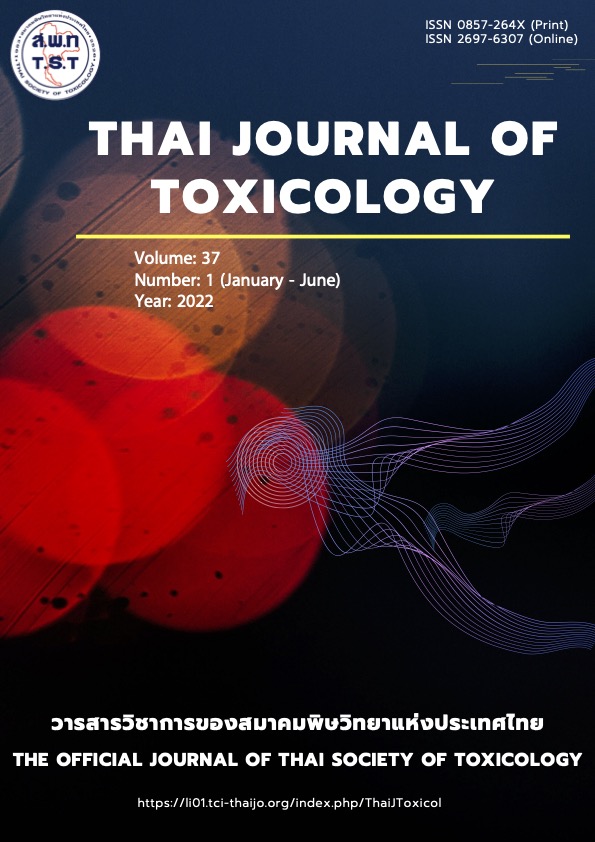The Importance of Method Validation for Risk Assessment of Exposure to Chemicals in Foods
Main Article Content
Abstract
Risk assessment of chemicals in foods is the scientific principle, which consists of 4 steps: 1) hazard identification, 2) hazard characterization, 3) exposure assessment and 4) risk characterization. Step 1 and 2 require toxicity data from animal or human studies, and require measurements of biochemical concentrations that indicate the body's response to chemical exposure. Then, method validation is required for measurement method. In the step 3, it is the step to acquire the amount of food consumption and concentration of a chemical of interest. The sources of concentration data may be derived from the allowance maximum levels of contaminants and food additives or from laboratory analysis of the chemical of interest. Nevertheless, whether the acquired concentration will be reliable, method validation is needed to be performed to provide an information related to the method characteristics and performances. Because in the risk assessment there is no zero risk, the limit of detection and limit of quantitation of test methods are considered for calculating an exposure to chemicals of interest. The benefits of method validation do not only provide the efficiency and reliability of the method itself but also provide benefit in protecting consumer health.
Article Details
References
FAO/WHO. Principles and methods for the risk assessment of chemicals in food. Environmental Health Criteria 240, 2009. Available at https://www.who.int/publications/i/item/9789241572408, accessed on Mar 9, 2022.
สำนักงานมาตรฐานสินค้าเกษตรและอาหารแห่งชาติ. 2548. หลักการทำงานในการวิเคราะห์ความเสี่ยง (working principles for risk analysis). ราชกิจจานุเบกษา ฉบับประกาศทั่วไป เล่ม 122 ตอนที่ 122 ง วันที่ 22 ธันวาคม พุทธศักราช 2548.
FAO/WHO. Working principles for risk analysis for application in the framework of the Codex Alimentarius. In: Codex Alimentarius Commission: procedural manual. 14thed. Joint FAO/WHO Food Standards Programme, 2004, 101- 7.
ISO/IEC 17025: General requirements for the competence of testing and calibration laboratories. International Organization for Standardization and International Electro-technical Commission. Geneva. 2017. 30 p.
ASEAN. Technical guidelines to ACTR on quality: ASEAN analytical validation guideline, 1996. Available at https://asean.org/wp-content/uploads/2012/10/Asean-Analytical-Validation-gl.pdf, accessed on Apr 20, 2022.
Magnusson B, and Örnemark U. Eurachem guide: the fitness for purpose of analytical methods – a laboratory guide to method validation and related topics. 2nd ed., 2014. Available at https://www.eurachem.org/images/stories/Guides/pdf/MV_guide_2nd_ed_EN.pdf, accessed on Feb 5, 2022.
ICH. Harmonised tripartite guideline validation of analytical procedures: text and methodology Q2 (R1), 2005. Available at https://database.ich.org/sites/default/files/Q2%28R1%29%20Guideline.pdf, accessed on Apr 20, 2022.
AOAC: Official methods of analysis of the association of official analytical chemists: official methods of analysis of AOAC international, 21st ed. Washington DC., 2019.
European Commission. Guidance document on analytical quality control and method validation procedures for pesticide residues and analysis in food and feed. Document No. SANTE/11813/2017, 2017. 42 p.
Huber L. Validation and qualification in analytical laboratories, 2nd ed. Informa Healthcare, 2007. 288 p.
AOAC. Peer-verified methods program, manual on policies and procedures. AOAC International, Rockville, 1998.
Wenzl T, Headrich J, Schaechtele A, et al. Guidance document on the estimation of LOD and LOQ for measurements in the field of contaminants in feed and food. European Union Reference Laboratory 2016: 9-11. Available at https://data.europa.eu/doi/10.2787/8931, accessed on May 4, 2022.
EFSA. Management of left-censored data in dietary exposure assessment of chemical substances. EFSA Journal 2010; 8: 1557 Available at https://efsa.onlinelibrary.wiley.com/doi/epdf/10.2903/j.efsa.2010.1557, accessed on Mar 27, 2022.
WHO. Second workshop on reliable evaluation of low-level contamination of food. Report on a workshop in the frame of GEMS/Food-EURO, GEMS/Food-EURO. World Health Organization Regional Office for Europe, Kulmbach, Rome. 1995.
Helsel DR. Less than obvious-statistical treatment of data below the detection limit. Environ Sci Technol 1990; 24: 1766-74.
International Life Science Institute (ILSI). Aggregate exposure assessment. Washington DC, International Life Sciences Institute Research Foundation, Risk Science Institute, 1998. 215 p.


